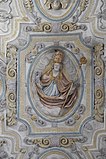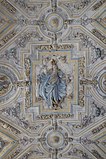St. Emmeram (Kleinhelfendorf)
The Catholic parish church St. Emmeram in Kleinhelfendorf , a parish village in the municipality of Aying in the district of Munich in the southeast of the Bavarian capital, was built on the site of a Romanesque predecessor in the second half of the 17th century by the Munich court architect Constantin Pader in the Baroque style . A special feature of the church is the rich stucco decoration with which the ceilings and walls are covered. The church consecrated to St. Emmeram of Regensburg is a protected architectural monument .
history
According to legend, St. Emmeram is said to have been tortured and killed in Kleinhelfendorf in 652 on his way to Rome. The first baptistery was consecrated in the village as early as the 8th century. The immediate predecessor of today's parish church was a church built in the 12th century from tuff blocks, of which parts of the nave , the tower substructure and a round arch frieze with a tooth cut of the original tower outer wall have been preserved.
From 1466 a new Gothic style choir was built on the site of the Romanesque apse , the nave was extended to the west and the five-sided sign added. In 1631 the tower octagon was built and covered with an onion hood , stone balls were walled in as decoration. In the years 1649/50 the new building of the nave began, in 1668/69 the walls of the choir, nave and portico were raised and all parts of the room were newly vaulted. The octagonal sacristy was added to the south side . The church was consecrated in 1680.
architecture
The single nave nave is divided into four axes . The slightly retracted choir is closed on three sides. The choir and nave are covered by barrels with lancet caps that rest on flat pillars with Corinthian pilasters . Double rows of windows illuminate the interior. High windows with rounded top and bottom have been cut between the pillars, and round oculi open over the cranked cornice . A double gallery forms the western end of the nave . The nine panels on the lower gallery, painted towards the end of the 17th century, depict scenes from the legend of St. Emmeram. The organ is built into the upper gallery .
Piece
The stucco frame, combined with figurative motifs, with which the ceilings and walls are covered, is very similar to the stucco decoration created by Constantin Pader for the former Cistercian monastery church of the Assumption of Mary in Niederschönenfeld and was probably carried out in two phases. In the first phase around 1670/80, stucco masons from Schliersee were at work, who created the geometric stucco frame. In a second phase towards the end of the 17th century, more sculptural elements were added. In the middle of the choir ceiling, St. Emmeram is enthroned, surrounded by four angels who hold knives and the chopped off hands and feet of the church patron. On the ceiling of the nave, Maria is depicted as Patrona Bavariae , the patron saint of Bavaria. The pillars adorn fruit baskets, garlands, ribbons and angel heads. In 1783 the stucco was painted over in pastel tones by Kaspar Weidtinger (Caspar Weidinger).
Furnishing
- The high altar is marked with the year 1679. It was made according to a design by Andreas Leisberger. In the excerpt , God the Father is enthroned , the apostles Peter and Paul are depicted on the side of the segment gables , in the top center stands the Archangel Michael with a flame sword and soul scales. The monumental seated figure of St. Emmeram in the altar shrine is dated to the late 15th century and is attributed to Erasmus Grasser . The larger-than-life side figures represent St. George on the left and St. Sebastian on the right .
- The two side altars also date from around 1670/80. On the northern altarpiece are the Evangelist Matthew and Saint Barbara kneeling in front of the Mother of God, on the southern altar you can see Saint Christopher and Saint Laurence , who venerate the Trinity .
- The carving of the Pietà on the north wall of the choir stalls from the first third of the 18th century.
- Next to it you can see a small wooden relief depicting the death of the Virgin . It originally belonged to a women's altar donated in 1498.
- On the north wall of the nave stands the group of figures of the Instruction of Mary on a gilded wooden base. The half-length figure of St. Anne from the second half of the 18th century is perhaps a work by Franz Xaver Schmädl . Relics are kept in the glazed wooden base .
- The choir stalls , carved from oak in cartilage style , like the lay stalls, date from around 1670/80.
- A candlestick angel and a pietà are depicted on two poles attached to the choir stalls.
- The pulpit is a work from 1672. On the cover is John the Baptist .
- The lecture cross from 1520/30 on the front pew has a removable body with movable arms. The figure of Christ was previously placed in the Holy Sepulcher , which was built in front of the high altar, during Holy Week .
- The red marble baptismal font has a diamond base and a twisted shaft from the late Gothic period around 1500, the basin dates from the Baroque period. The baptismal group was created around 1680.
literature
- Hubert Bechteler, Claus Broghammer: Parish Church of St. Emmeram in Kleinhelfendorf . Catholic Church Foundation St. Emmeram (ed.), Christian Art in Bavaria, No. 18, Verlag St. Peter, Salzburg 2007.
- Georg Dehio : Handbook of German Art Monuments - Bavaria IV - Munich and Upper Bavaria. 2nd edition, Deutscher Kunstverlag , Munich 2002, ISBN 3-422-03010-7 , pp. 539-540.
- Georg Paula , Timm Weski: District of Munich (= Bavarian State Office for Monument Preservation [Hrsg.]: Monuments in Bavaria . Volume I.17 ). Karl M. Lipp Verlag, Munich 1997, ISBN 3-87490-576-4 , p. 24-26 .
Web links
Individual evidence
- ^ Holy Emmeram Archdiocese of Munich and Freising
Coordinates: 47 ° 56 ′ 35 ″ N , 11 ° 48 ′ 14 ″ E














